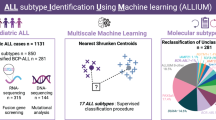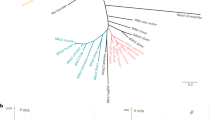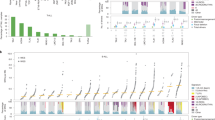Abstract
We have conducted a detailed structural analysis of 90 kilobases (kb) of the HLA Class III region from the Bat2 gene at the centromeric end to 23 kb beyond TNF. A single contig of 80 kb was sequenced entirely with a group of four smaller contigs covering 10 kb being only partly sequenced. This region contains four known genes and a novel telomeric potential coding region. The genes are bracketed by long, dense clusters of Alu repeats belonging to all the major families. At least six new families of MER repeats and one pseudogene are intercalated within and between the Alu clusters. The most telomeric 3.8 kb contains three potential exons, one of which bears strong homology to the ankyrin domain of the DNA binding factors NFκB and IκB.
Similar content being viewed by others
Article PDF
References
Batchelor, J.R. & McMichael, A.J. Progress in understanding HLA and disease associations. Br. Med. Bull. 43, 156–183 (1987).
Crumpton, M.J. HLA in medicine: Introduction. Br. Med. Bull. 43, i–vi (1987).
Sargent, C.A., Dunham, I. & Campbell, R.D. Identification of multiple HTF-island associated genes in the human major histocompatibility complex class III. EMBO J. 8, 2305–2312 (1989).
Kendall, E., Sargent, C.A. & Campbell, R.D. Human major histocompatibility complex contains a new cluster of genes between the HLA-D and complement C4 loci. Nucl. Acids Res. 24, 7251–7257 (1990).
Milner, C.M. & Campbell, R.D. Structure and expression of the three MHC-linked HSP70 genes. Immunogenetics 32, 242–251 (1990).
Benjamin, R. & Parham, P. Guilt by association: HLA-B27 and ankylosing spondylitis. Immunol. Today 11, 137–142 (1990).
Jacob, C.O. et al. Heritable MHC class II-associated differences in production of tumor necrosis factor a: Relevance to genetic predisposition to systemic lupus herytematosus. Proc. natn. Acad. Sci. U.S.A. 87, 1233–1237 (1990).
Rubinstein, P. HLA and IDDM: Facts and speculations on the disease gene and its mode of inhertance. Hum. Immunol. 30, 270–277 (1991).
Nepom, G.T. A unified hypothesis for the complex genetics of HLA associations with IDDM. Diabetes 39, 1153–1157 (1990).
Raum, D., Alper, C.A. & Stein, R. Genetic markers for insulin dependent diabetes mellitus. Lancet 2, 1208–1213 (1979).
Spies, T., Bresnahan, M. & Strominger, J.L. Human major histocompatibility complex contains a minimum of 19 genes between the complement cluster and HLA-B. Proc. natn. Acad. Sci. U.S.A. 86, 8955–8958 (1989).
Banerji, J., Sands, J., Strominger, J.L. & Spies, T. A gene pairfrom the human major histocompatibility complex encodes large proline-rich proteins with multiple repeated motifs and a single ubiquitin-like domain. Proc. natn. Acad. Sci. U.S.A. 87, 2374–2378 (1990).
French, M.A.H. & Dawkins, R.L. Central MHC genes, IgA deficiency and autoimmune disease. Immunol. Today 11, 271–273 (1990).
Nedospasov, S.A. et al. Tandem arrangement of genes coding for tumor necrosis factor (TNFa) and lymphotoxin (TNFb) in the human genome. Cold Spring Harb. Symp. Quant. Biol. 51, 611–624 (1986).
Jurka, J. & Milosavljevic, A. Reconstruction and analysis of human Alu genes. J. molec. Evol. 32, 105–121 (1991).
Kerian, K. et al. The DNA binding subunit of NFκB is identical to factor KBF1 and homologous to the rel oncogene product: Cell 62, 1007–1018 (1990).
Hasskill, S. et al. Characterisation of an immediate-early gene induced in adherent monocytes that encodes IkB-like activity. Cell 65, 1281–1289 (1991).
Yang, S.Y. Assignment of HLA-A and HLA-B antigens for the reference panel of B-lymphoblastoid cell lines determined by one-dimentional isoelectric focusing (1D-IEF) gel electrophoresis. In Immunobiology of HLA Vol. 1 (ed. Dupont, B.) 12, 14, 16, 43–47 & 1079 (Springer, New York, 1987).
Deininger, P.L. Random subcloning of sonicated DNA: Application to shotgun DNA sequence analysis. Anal. Biochem. 129, 216–223 (1983).
Dear, S. & Staden, R. A sequence assembly and editing program for efficient management of large projects. Nucl. Acids Res. 14, 3907–3911 (1991).
Pearson, R.W. & Lipman, D.J. Improved tools for biological sequence comparison. Proc. natn. Acad. Sci. U.S.A. 85, 2444–2448 (1988).
Karlin, S. & Altschul, S.T. Methods for assessing the statistical significance of molecular sequence features by using general scoring schemes. Proc. natn. Acad. Sci. U.S.A. 87, 2264–2268 (1990).
Claverie, J-M. & Bougueleret, L. Heuristic informational analysis of sequences. Nucl. Acids Res. 14, 179–196 (1986).
Uberbacher, E.C. & Mural, R.J. Locating protein-coding regions in human DNA by a multiple sensor neural network approach. Proc. natn. Acad. Sci. U.S.A. 88, 11261–11265 (1991).
Tsuge, I., Shen, F.W., Steinmetz, M. & Boyse, E.A. A gene in the H-2S: H-2D interval in the major histocompatibility complex which is transcribed in B cells and macrophages. Immunogenetics 26, 378–380 (1987).
Degen, S.J. & Davies, E.W. Nucleotide sequence of the gene for human prothrombin. Biochemistry 26, 6165–6177 (1987).
Liew, C.C. et al. Complete sequence organisation of the human cardiac beta-myosin heavy chain gene. Nucl. Acids Res. 18, 3647–3651 (1990).
Jurka, J. & Zuckerkandl, E. Free left arms as precursor molecules in the evolution of Alu sequences. J. molec. Evol. 33, 49–56 (1991).
Jurka, J. & Smith, T. A fundamental division in the Alu family of repeated sequences. Proc. natn. Acad. Sci. U.S.A. 85, 4775–4778 (1988).
Kaplan, D.J., Jurka, J., Solus, J.F. & Duncan, C.H. Medium reiteration repetitive sequences in the human genome. Nucl. Acids Res. 19, 4731–47398 (1991).
Li, Z., Lilienbaum, A, Butler-Brown, G. & Paulin, D. Human desmin-coding gene: complete nucleotide sequence, characterisation and regulation of expression during myogenesis and development. Gene 78, 243–254 (1989).
Koller, M., Baumer, A. & Strehler, E.E. Characterisation of two novel human retropseudogenes related to the calmodulin-encoding gene Cam II. Gene 97, 245–251 (1991).
Hourcade, D., Meisner, D.R., Bee, C., Zeldes, W. & Atkinson, J.P. Duplication and divergence of the amino terminal coding region of the complement receptor 1 (CR1) gene: an example of concerted (horizontal) evolution within a gene. J. biol. Chem. 265, 974–980 (1990).
Ma, T.S. et al. Serial Alu sequence transposition interrupting a human β-creatine kinase pseudogene. Genomics 10, 390–399 (1991).
Shipp, M.A. et al. Molecular cloning of the common acute lymphoblastic leukemia antigen (CALLA) identifies a type II intergral membrane protein. Proc. natn. Acad. Sci. U.S.A. 85, 4819–4823 (1988).
Wang, A.M. & Desnick, R.J. Structural organisation and complete sequence of the human α-N-acetylgalactosaminidase gene: homology with the a-galactosidase A gene provides evidence for evolution from a common ancestral gene. Genomics 10, 133–142 (1991).
Toda, K. et al. Structural and functional characterisation of human aromatase P-450 gene. Eur. J. Biochem. 193, 559–565 (1990).
The, V.L. et al. Structure of two in tendem human estardiol 17-b-dehydrogenase gene. Molec. Endochnol. 4, 268–275 (1990).
Jurka, J., Walichiewicz, J. & Milosavljevic, A. Prototypic sequences for human repetitive DNA. J. molec. Evol .(in the press).
Otha, S., Goto, K., Arai, H. & Kagawa, Y. An extremely acidic amino-terminal presequence of the precursor for the human mitochondrial hinge protein. FEBS Lett. 226, 171–175 (1987).
Stoppa-Lyonnet, D., Carter, P.E., Meo, T. & Tosi, M. Clusters of intragenic Alu repeats predispose the human C1 inhibitor locus to deleterious rearrangements. Proc. natn. Acad. Sci. U.S.A. 87, 1551–1555 (1990).
Edwards, A. et al. Automated DNA sequencing of the human HPRT locus. Genomics 6, 593–608 (1989).
Legouis, R. et al. The candidate gene for the X-linked Kallmann syndrome encodes a protein related to adhesion molecules. Cell 67, 423–435 (1991).
Martin-Gallardo, A. et al. Automated DNA sequencing and analysis of 106 kilobases from human chromosome 19q13.3. Nature Genet. 1, 34–39 (1992).
McCombie, W.R. et al. Expressed genes, Alu repeats and polymorphisms in cosmids sequenced from chromosome 4p16.3. Nature Genet. 1, 358–353 (1992).
Chen, S.J. et al. Ph1+bcr- acute leukemias: implication of Alu sequences in a chromosomal translocation occurring in the new cluster region with the BCR gene. Oncogene 4, 195–202 (1989).
Ohno, H., Takimoto, G. & Mckeihan, T.W. The candidate proto-oncogene bcl-3 is related to genes implicated in cell lineage determination and cell-cycle control. Cell 60, 991–997 (1990).
Hannahan, D. Studies of transformation of Escherichia coli with plasmids. J. molec. Biol. 166, 157–162 (1983).
Author information
Authors and Affiliations
Rights and permissions
About this article
Cite this article
Iris, F., Bougueleret, L., Prieur, S. et al. Dense Alu clustering and a potential new member of the NFκB family within a 90 kilobase HLA Class III segment. Nat Genet 3, 137–145 (1993). https://doi.org/10.1038/ng0293-137
Received:
Accepted:
Issue date:
DOI: https://doi.org/10.1038/ng0293-137
This article is cited by
-
Investigation of the acute pathogenesis of spondyloarthritis/HLA-B27-associated anterior uveitis based on genome-wide association analysis and single-cell transcriptomics
Journal of Translational Medicine (2024)
-
Correlation of AIF-1 Expression with Immune and Clinical Features in 1270 Glioma Samples
Journal of Molecular Neuroscience (2022)
-
Intravenous infusion of bone marrow mononuclear cells promotes functional recovery and improves impaired cognitive function via inhibition of Rho guanine nucleotide triphosphatases and inflammatory signals in a model of chronic epilepsy
Brain Structure and Function (2020)
-
HLA and SNP haplotype mapping in the Japanese population
Genes & Immunity (2012)
-
Daintain/AIF-1 promotes breast cancer cell migration by up-regulated TNF-α via activate p38 MAPK signaling pathway
Breast Cancer Research and Treatment (2012)



